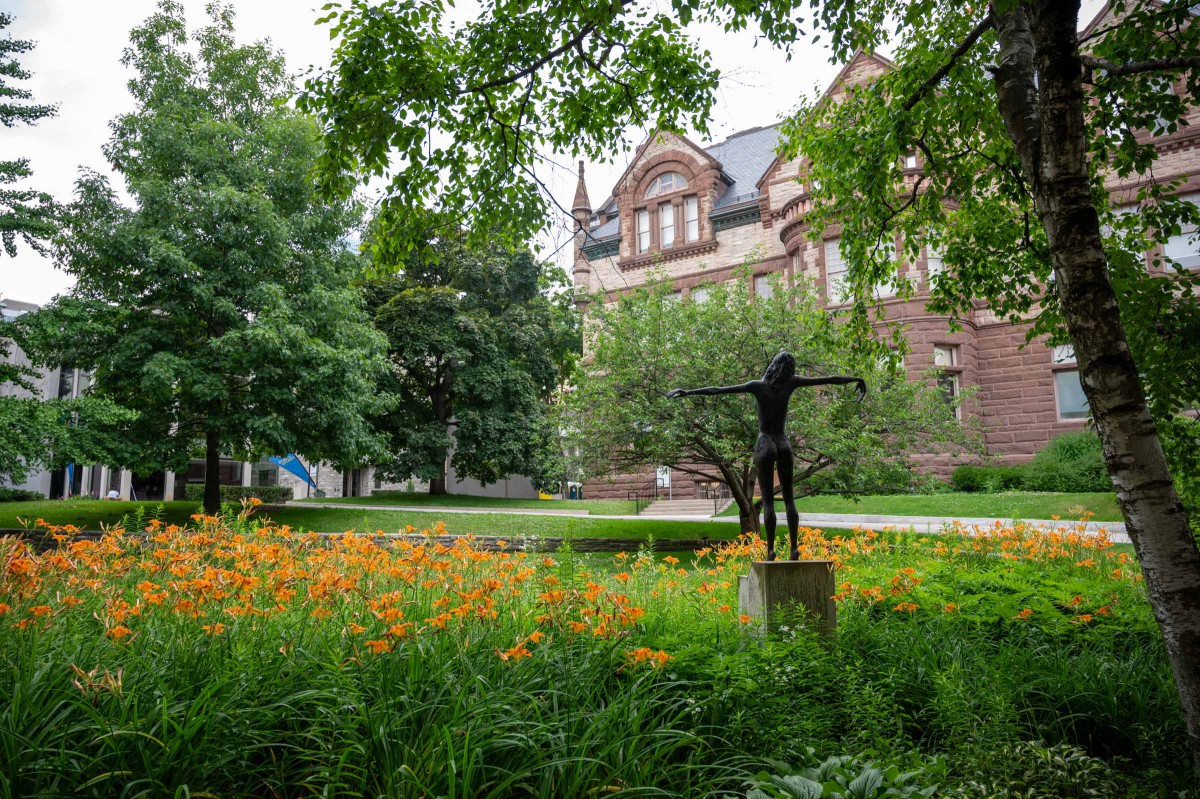Planting an Indigenous Healing Garden

An Indigenous Healing Garden will be built adjacent to Emmanuel College where the "Crucified Woman" sculpture now stands. The garden will be fully accessible and there will be a new accessible entrance to the east side of the college itself. (Photo by Minh Truong)
By Leslie Shepherd
An Indigenous Healing Garden will soon take root at Emmanuel College, growing into a space for reflection, truth and reconciliation, and learning about Indigenous traditions and stewardship of the land.
The garden, created in consultation with Indigenous advisers and various stakeholders, is being built on the east side of the college’s Gothic style building at Queen’s Park and Charles Street. It will be fully accessible and ecologically sustainable, growing Indigenous sacred medicinal plants, as well as vegetables and wildflowers.
Work on the garden was set to begin this fall, with an expectation of an official opening during the spring of 2025. to coincide with celebrations for the United Church of Canada’s centennial. Next year is also the 10th and 15th anniversaries for the Buddhist and Muslim foci of the Master of Psychospiritual Studies at Emmanuel, followed by the centenary of Emmanuel’s founding in 2028.
Creating the garden is part of Victoria University’s commitment to the Truth and Reconciliation process and was a priority for Emmanuel College Principal HyeRan Kim-Cragg when she was installed in 2022. “This is a dream come true,” she said.
Victoria University President Dr. Rhonda McEwen called the garden “a tangible realization of our commitment to build relationships between and among Indigenous and non-Indigenous peoples.”
“We like to talk about Vic’s beautiful campus, but beauty is more than just aesthetics; there is beauty in recognizing the land,” she said. “The garden will also be a tangible symbol of respecting the land, the Earth, the soil and the water and the things that grow, nourish and heal us.”
Kim-Cragg said the garden is aligned with Vic U’s Strategic Framework, which commits us to intensify sustainability initiatives across the entire university. Grass, which requires a lot of water to grow and stay green, will be replaced with plants native to this area that will also attract bees and butterflies.
Jonathan Hamilton-Diabo, the June Callwood Professor of Social Justice and adviser on Indigenous issues to the president of Victoria University, said he expects the new plants to include sage and sweet grass, which are used in various ceremonies, such as smudging. Cedar, which can be brewed for tea, and tobacco, often used when inviting or thanking someone for doing something, or offered in a fire bring thoughts and prayers to the Creator, are also being considered.
Kim-Cragg said she hoped that the garden would become part of Emmanuel College’s academic curriculum, focusing on Indigenous cultures and our relationship to the land, with classes taking place in the garden, weather permitting.
This would support a call to action from Canada’s Truth and Reconciliation Commission for theological schools to “develop and teach curriculum for all student clergy, and all clergy and staff who work in Aboriginal communities, on the need to respect Indigenous spirituality in its own right.”
Hamilton-Diabo said the garden’s prominent location in the middle of Victoria University was important. He said it would be a visual indication showing an Indigenous presence in the University of Toronto and the city of Toronto.
“It shows our university community, and attending Indigenous students, the importance of visibility of Indigenous cultures on campus. It will acknowledge that there is an active Indigenous community at the university, that we are not relics of the past but are still here in many different ways.”
Hamilton-Diabo said locating the garden adjacent to Emmanuel College, one of the country’s leading theological schools, recognizes the healing and reconciliation that still needs to be rebuilt between some Indigenous people and churches.
He said that after much discussion with the Indigenous advisers, the “Crucified Woman” sculpture will remain in its current location and be part of the new garden. He said that while many people see it as a Christian symbol, its original intent was to represent the universal suffering of women.
The Indigenous Healing Garden received a Seeds of Hope grant from the United Church of Canada to literally seed this project. Vic’s Office of Alumni Affairs & Advancement is also working to raise $500,000 through naming opportunities for benches, walkways, flower beds and paver stones. If you would like to donate, please email vic.alumni@utoronto.ca or call 416-585-4500 or and ask to speak to Director of Philanthropy Mary Heinmaa.
